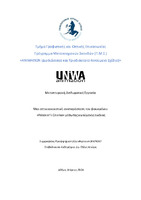| dc.contributor.advisor | Μούρη, Ελένη | |
| dc.contributor.author | Προφητηλιώτη, Ελευθερία | |
| dc.date.accessioned | 2024-04-09T06:41:03Z | |
| dc.date.available | 2024-04-09T06:41:03Z | |
| dc.date.issued | 2024-04-04 | |
| dc.identifier.uri | https://polynoe.lib.uniwa.gr/xmlui/handle/11400/6433 | |
| dc.identifier.uri | http://dx.doi.org/10.26265/polynoe-6269 | |
| dc.description | Θεματική περιοχή: 2d animation | el |
| dc.description.abstract | Η παρούσα διπλωματική εργασία εμβαθύνει στο φαινόμενο “Prisoner’s Cinema”, χρησιμοποιώντας
το μέσο των κινουμένων σχεδίων για να εξερευνήσει και να απεικονίσει αυτή την εμπειρία
οπτικοακουστικών ψευδαισθήσεων. Η ταινία animation που δημιουργήθηκε για αυτήν την εργασία
χρησιμεύει τόσο ως αφηγηματικό όσο και ως αναλυτικό εργαλείο για τη διερεύνηση των γνωστικών
και αντιληπτικών πτυχών της παρατεταμένης αισθητηριακής απομόνωσης.
Η έρευνα έχει ως βάση την ανασκόπηση της υπάρχουσας βιβλιογραφίας, με έμφαση στο βιβλίο
«Ψευδαισθήσεις» με συγγραφέα τον νευρολόγο Oliver Sacks, ο οποίος, αφηγείται ιστορίες και
περιστατικά ψευδαισθήσεων των ασθενών του αλλά και προσωπικές. Επιπλέον, στο βιβλίο αυτό,
παρουσιάζει επιστημονικά δεδομένα, διευκρινίζοντας ορισμένα χαρακτηριστικά και δομές του
εγκεφάλου. Επιπρόσθετα, η έρευνα δίνει βάση στις πραγματικές αναφορές, που προκύπτουν μέσω
δύο ερευνών- πειραμάτων όπως «Οι επιδράσεις της μειωμένης διακύμανσης στο αισθητηριακό
περιβάλλον» που διεξήχθη από τους Bexton, W. H., Heron, W., & Scott, T. H. (1954), του
Πανεπιστημίου McGill και την έρευνα των Zubek, J. P., Pushkar, D., Sansom, W. και Gowing, J. (1961)
«Αντιληπτικές αλλαγές μετά από παρατεταμένη αισθητηριακή απομόνωση (στο σκοτάδι και στη
σιωπή)» θέτοντας τα θεμέλια για την κατανόηση του αντίκτυπου της αισθητηριακής στέρησης στον
ανθρώπινο νου.
Η ταινία animation που δημιουργήθηκε, βασικό στοιχείο αυτής της έρευνας, χρησιμοποιεί ένα
μείγμα οπτικής αφήγησης και καλλιτεχνικής ερμηνείας, ενσωματώνοντας ιδέες από την ψυχολογία
και τη νευρολογία, για να μεταφέρει την προσομοίωση αυτού του φαινομένου που προκύπτει
έπειτα από μακροχρόνιο αισθητηριακό περιορισμό. Η αφήγηση εκτυλίσσεται μέσα από ένα
σκηνικό, ενός οποιουδήποτε σκοτεινού χώρου, χρησιμοποιώντας συμβολισμούς και μεταφορικά
στοιχεία για να αποτυπώσει την περίπλοκη αλληλεπίδραση μεταξύ αντίληψης, φαντασίας και
πραγματικότητας.
Τα ευρήματα αυτής της έρευνας, συμβάλλουν τόσο στα πεδία της ψυχολογίας όσο και στο
animation εξετάζοντας την ανθρώπινη ψυχή σε κατάσταση περιορισμού και την ικανότητα των
καλλιτεχνικών μέσων, να δίνουν φως, εξερευνώντας πολύπλοκα ψυχολογικά φαινόμενα. | el |
| dc.format.extent | 60 | el |
| dc.language.iso | el | el |
| dc.publisher | Πανεπιστήμιο Δυτικής Αττικής | el |
| dc.rights | Αναφορά Δημιουργού - Μη Εμπορική Χρήση - Παρόμοια Διανομή 4.0 Διεθνές | * |
| dc.rights | Attribution-NonCommercial-NoDerivatives 4.0 Διεθνές | * |
| dc.rights | Attribution-NonCommercial-NoDerivatives 4.0 Διεθνές | * |
| dc.rights.uri | http://creativecommons.org/licenses/by-nc-nd/4.0/ | * |
| dc.subject | 2d animation | el |
| dc.subject | Prisoner’s Cinema | el |
| dc.subject | Ψευδαισθήσεις | el |
| dc.subject | Νευρολογία | el |
| dc.subject | Αισθητηριακή στέρηση | el |
| dc.title | Μια οπτικοακουστική αναπαράσταση του φαινομένου "Prisoner's Cinema" μεσω της κινούμενης εικόνας | el |
| dc.title.alternative | An audio-visual representation of the phenomenon “Prisoner’s Cinema” through the motion picture | el |
| dc.type | Μεταπτυχιακή διπλωματική εργασία | el |
| dc.contributor.committee | Μούρη, Ελένη | |
| dc.contributor.committee | Τσιάρα, Μάρθα | |
| dc.contributor.committee | Μετζητάκος, Ρωσσέτος | |
| dc.contributor.faculty | Σχολή Εφαρμοσμένων Τεχνών & Πολιτισμού | el |
| dc.contributor.department | Τμήμα Γραφιστικής και Οπτικής Επικοινωνίας | el |
| dc.contributor.master | ΑΝΙΜΑΤΙΟΝ (Δισδιάστατο και Τρισδιάστατο Κινούμενο Σχέδιο) | el |
| dc.description.abstracttranslated | This thesis delves into the “Prisoner’s Cinema” phenomenon, using the medium of animation to
explore and illustrate this experience of audiovisual hallucinations. The animation film created for
this paper, could be used both as narrative and an analytical tool, to explore the cognitive and
perceptual aspects of prolonged sensory deprivation.
The research is based on the review of the existing bibliography, with an emphasis on the book
"Hallucinations" authored by the neurologist Oliver Sacks, who tells stories and incidents of
hallucinations of his patients as well as personal ones. In addition, in this book, he presents scientific
data, clarifying certain characteristics and structures of the brain. Moreover, the research provides
information of factual reports, obtained through two research-experiments such as "The Effects of
Decreased Variation in the Sensory Environment" conducted by Bexton, W. H., Heron, W., & Scott, T.
H. (1954), of McGill University and the research of Zubek, J. P., Pushkar, D., Sansom, W. and Gowing,
J. (1961) “Perceptual changes after prolonged sensory isolation (darkness and silence)”, that lay the
foundation for understanding the impact of sensory deprivation on the human mind.
The resulting animation film, a key element of this research, uses a mixture of visual storytelling and
artistic interpretation, incorporating ideas from psychology and neurology to convey the simulation
of this phenomenon resulting from long-term sensory deprivation. The narrative unfolds through a
setting, of an any dark space, using symbolism and metaphor to capture the complex interplay
between perception, imagination and reality.
The findings of this research contribute to both fields of psychology and animation by examining the
human psyche in a state of limitation and the ability of artistic media to shed light by exploring
complex psychological phenomena. | el |


